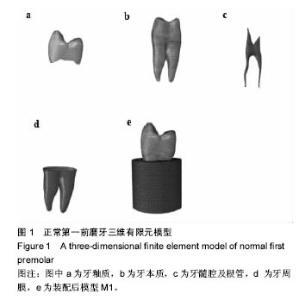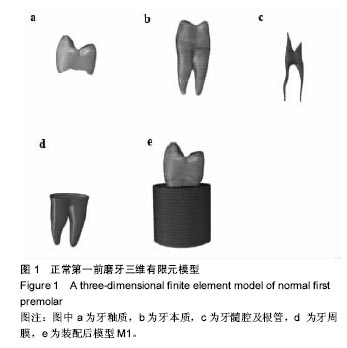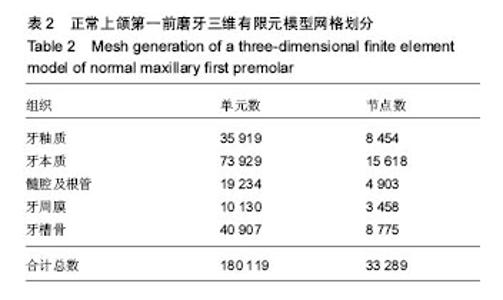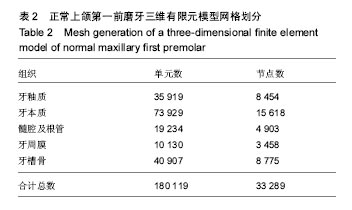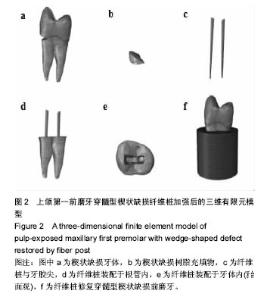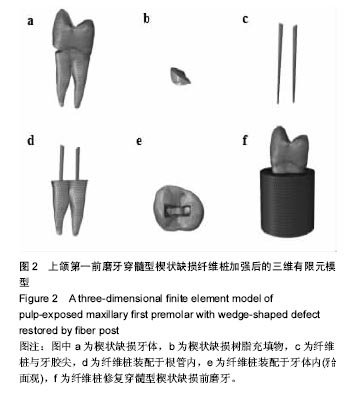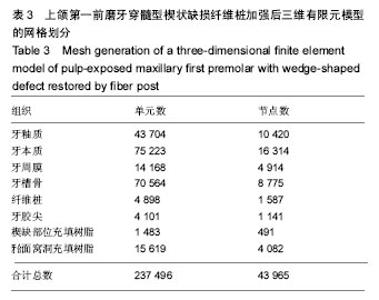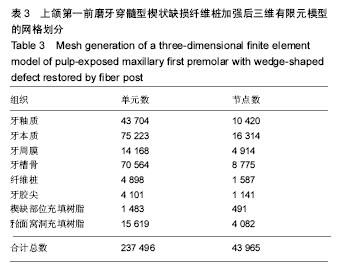Chinese Journal of Tissue Engineering Research ›› 2018, Vol. 22 ›› Issue (2): 183-188.doi: 10.3969/j.issn.2095-4344.0004
Previous Articles Next Articles
Construction of a three-dimensional finite element model of pulp-exposed maxillary premolar with wedge-shaped defect restored by fiber post
- 1Shanghai Delun Dental Clinic, Shanghai 200041, China; 2Department of Stomatology, Shanghai Huashan Hospital, Shanghai 200041, China; 3Department of Prosthodontics, Shanghai Stomatological Disease Center, Shanghai 200031, China
-
Received:2017-08-14Online:2018-01-18Published:2018-01-18 -
Contact:Shen Qing-yi, Associate chief physician, Department of Prosthodontics, Shanghai Stomatological Disease Center, Shanghai 200031, China -
About author:Mo Si-su, M.D., Attending physician, Shanghai Delun Dental Clinic, Shanghai 200041, China Bao Wei, Master, Attending physician, Department of Stomatology, Shanghai Huashan Hospital, Shanghai 200041, China Mo Si-su and Bao Wei contributed equally to this work. -
Supported by:Shanghai Municipal Health Bureau Project, No. 20114136
CLC Number:
Cite this article
Mo Si-su, Bao Wei, Shen Qing-yi.
share this article
Add to citation manager EndNote|Reference Manager|ProCite|BibTeX|RefWorks
| [1]Levitch LC,Bader JD,Shugars DA,et al.Non-carious cervical lesions.J Dent.1994;22(4):195-207.[2]Barttlet DW,Shah P.A critical review of non-carious cervical lesions and the role of abfraction, erosion, and abrasion.J Dent Res.2006;85(4):306-312.[3]Bader JD,Levitch LC,Shugars DA,et al.How dentists classified and treated non-carious cervical lesions.J Am Dent Assoc. 1993;124(5):46-54.[4]刘洪臣,王燕一,赵彦平.230例老年人牙折修复的临床分析[J].口腔颌面修复学杂志,2000,1(3):154-155.[5]皮昕.口腔解剖生理学性[M].6版.北京:人民卫生出版社, 2007: 9.[6]De Santis R,Prisco D,Apicella A,et al.Carbon post adhesion to resin luting cement in the restoration of endodontically treated teeth.J Mater Sci Mater Med.2000;11(4):201-206.[7]Ferrari M,Vichi A,Gareia-Godoy F.Clinical evaluation of fiber-reinforced epoxy resin posts and cast post and cores.Am J Dent.2000;13(Spec No):15B-18B.[8]Asmussen E,Peutzfeldt A,Heitmann TS.Elastic limit and strength of newer types of endodontic posts.J Dent. 1999; 27(4):275-278.[9]Imanishi A, Nakamura T, Ohyama T, et al. 3-D Finite element analysis of all-ceramic posterior crowns. J Oral Rehabil. 2003;30(8):818-822[10]Litonjua LA,Andreana S,Bush PJ,et al.Non carious cervical lesions and Abfractions:A Re-evalution.J Am Dent Assoc. 2003;134(7):845-850.[11]刘彦,牛忠英,石馨,等.2038 例中老年人健康体检中牙齿楔形缺损的调查和分析[J].牙体牙髓牙周病学杂志, 2010,20(11): 645-647.[12]Dietschi D,Duc O,Krejci I,et al.Biomechanical considerations for the restoration of endodontically treated teeth:a systematic review of the literature,PartⅡ(Evaluation of fatigue behavior, interfaces, and in vivo studies).Quintessence Int. 2008;39(2): 117-129.[13]许琳,朱文军,程绍华,等.纤维桩对复合树脂修复根管治疗后磨牙影响的有限元研究[J].中华口腔医学研究杂志, 2014,8(1): 18-22.[14]Costa A, Xavier T, Noritomi P, et al. The influence of elastic modulus of inlay materials on stress distribution and fracture of premolars. Oper Dent. 2014;39(4):E160-E170. [15]Oyar P, Ulusoy M, Eskitas?ç?og?lu G. Finite element analysis of stress distribution in ceramic crowns fabricated with different tooth preparation designs. J Prosthet Dent. 2014;112(4) : 871-877. [16]Murakami K, Yamamoto K, Tsuyuki M, et al. Theoretical efficacy of preventive measures for pathologic fracture after surgical removal of mandibular lesions based on a three-dimensional finite element analysis. J Oral Maxillofac Surg. 2014;72(4):833. [17]Durmus? G, Oyar P. Effects of post core materials on stress distribution in the restoration of mandibular second premolars: A finite element analysis. J Prosthet Dent. 2014; 112(3): 547-554. [18]Cui C, Sun J. Optimizing the design of bio-inspired functionally graded material (FGM) layer in all-ceramic dental restorations. Dent Mater J. 2014;33(2):173-178. [19]Oyar P. The effects of post-core and crown material and luting agents on stress distribution in tooth restorations. J Prosthet Dent. 2014;112 (2) :211-219. [20]O'Brien S, Shaw J, Zhao X, et al. Size dependent elastic modulus and mechanical resilience of dental enamel. J Biomech. 2014;47(5):1060-1066. [21]Belli S, Eraslan O, Eraslan O, et al. Effects of NaOCl, EDTA and MTAD when applied to dentine on stress distribution in post-restored roots with flared canals. Int Endod J.2015; 47 (12) :1123-1132.[22]Costa A, Xavier T, Noritomi P, et al. The Influence of Elastic Modulus of Inlay Materials on Stress Distribution and Fracture of Premolars. Oper Dent. 2014;39(4):E160-170.[23]Lazari PC, Oliveira RC, Anchieta RB, et al. Stress distribution on dentin-cement-post interface varying root canal and glass fiber post diameters. A three-dimensional finite element analysis based on micro-CT data. J Appl Oral Sci. 2013;21(6): 511-517.[24]Zhao L, Li LJ, Zhao K, et al. Finite element analysis of first maxillary molars restored with different post and core materials. Shanghai Kou Qiang Yi Xue. 2013;22(6):607-612.[25]Park JW, Ferracane JL. Water aging reverses residual stresses in hydrophilic dental composites. J Dent Res. 2014;93(2):195-200.[26]Bicalho AA, Valdívia AD, Barreto BC, et al. Incremental filling technique and composite material--part II: shrinkage and shrinkage stresses. Oper Dent. 2014;39(2):E83-92.[27]Belli S, Eraslan Ö, Eraslan O, et al. Effect of restoration technique on stress distribution in roots with flared canals: an FEA study. J Adhes Dent. 2014;16(2):185-191.[28]Petcu CM,Nit?oi D,Mercut? V, et al. Masticatory tensile developed in upper anterior teeth with chronic apical periodontitis. A finite-element analysis study. Rom J Morphol Embryol. 2013;54(3):587-592.[29]Feitosa SA,Corazza PH,Cesar PF, et al. Pressable feldspathic inlays in premolars: effect of cementation strategy and mechanical cycling on the adhesive bond between dentin and restoration. J Adhes Dent.2014;16(2):147-154.[30]He L, Liu L, Gao B, et al. Finite element analysis of the stress distribution of two-piece post crown with different adhesives. Hua Xi Kou Qiang Yi Xue Za Zhi. 2013;31(4):348-352.[31]Su KC, Chuang SF, Ng EY, et al. An investigation of dentinal fluid flow in dental pulp during food mastication: simulation of fluid-structure interaction. Biomech Model Mechanobiol. 2014; 13(3):527-535.[32]Lü LW, Meng GW, Liu ZH.Finite element analysis of multi-piece post-crown restoration using different types of adhesives. Int J Oral Sci.2013;5(3):162-166.[33]Afroz S, Tripathi A, Chand P, et al. Stress pattern generated by different post and core material combinations: a photoelastic study. Indian J Dent Res. 2013;24(1):93-97.[34]缪羽,于蕴之,李婧,等.桩核对牙冠完整的上颌第一前磨牙的应力 影响[J].口腔颌面修复学杂志,2012,13(1):30-33.[35]Ona M, Wakabayashi N, Yamazaki T,et al. The influence of elastic modulus mismatch between tooth and post and core restorations on root fracture. Int Endod J. 2013;46(1):47-52.[36]Rubin C,Krishnamurthy N,Capilouto E,et al.Stress analysis of the human tooth using a three-dimensional finite element model.J Dent Res.1983;62(2):82-86.[37]Misch CM,Ismail YH.Finite element stress analysis of tooth-to-implant fixed partial denture designs.J Prosthodont. 1993;2(2):83-92.[38]Augereau D,Renault P,Pierrisnard L,et al.Three-dimensional finite element analysis of the retention of fixed partial dentures.Clin Oral Investig.1997;1(3):141-146.[39]Provatidis CG.Parametric finite element analysis and closed-form solutions in orthodontics. Comput Methods Biomech Biomed Engin.2002;5(2):101-112.[40]Wakabayashi N,Ona M,Suzuki T,et al.Nonlinear finite element analyses:advances and challenges in dental applications.J Dent.2008;36(7):463-471.[41]Kavanagh EP,Frawley C,Kearns G,et al.Use of finite element analysis in presurgical planning: treatment of mandibular fractures.Ir J Med Sci.2008;177(4):325-331.[42]宋健,崔剑,祝颂松,等.不同下颌角成形术后下颌骨受力的三维有限元分析[J].实用口腔医学杂志,2010, 26(4):491-494.[43]Buyukkurt MC,Tozoglu S,Yavuz MS,et al.Simulation of sinus floor augmentation with symphysis bone graft using three-dimensional computerized tomography.Int J Oral Maxillofac Surg.2010;39(8):788-792. |
| [1] | Zhang Tongtong, Wang Zhonghua, Wen Jie, Song Yuxin, Liu Lin. Application of three-dimensional printing model in surgical resection and reconstruction of cervical tumor [J]. Chinese Journal of Tissue Engineering Research, 2021, 25(9): 1335-1339. |
| [2] | Chen Xinmin, Li Wenbiao, Xiong Kaikai, Xiong Xiaoyan, Zheng Liqin, Li Musheng, Zheng Yongze, Lin Ziling. Type A3.3 femoral intertrochanteric fracture with augmented proximal femoral nail anti-rotation in the elderly: finite element analysis of the optimal amount of bone cement [J]. Chinese Journal of Tissue Engineering Research, 2021, 25(9): 1404-1409. |
| [3] | Zeng Yanhua, Hao Yanlei. In vitro culture and purification of Schwann cells: a systematic review [J]. Chinese Journal of Tissue Engineering Research, 2021, 25(7): 1135-1141. |
| [4] | Cai Qunbin, Zou Xia, Hu Jiantao, Chen Xinmin, Zheng Liqin, Huang Peizhen, Lin Ziling, Jiang Ziwei. Relationship between tip-apex distance and stability of intertrochanteric femoral fractures with proximal femoral anti-rotation nail: a finite element analysis [J]. Chinese Journal of Tissue Engineering Research, 2021, 25(6): 831-836. |
| [5] | Song Chengjie, Chang Hengrui, Shi Mingxin, Meng Xianzhong. Research progress in biomechanical stability of lateral lumbar interbody fusion [J]. Chinese Journal of Tissue Engineering Research, 2021, 25(6): 923-928. |
| [6] | Liu Zhao, Xu Xilin, Shen Yiwei, Zhang Xiaofeng, Lü Hang, Zhao Jun, Wang Zhengchun, Liu Xuzhuo, Wang Haitao. Guiding role and prospect of staging and classification combined collapse prediction method for osteonecrosis of femoral head [J]. Chinese Journal of Tissue Engineering Research, 2021, 25(6): 929-934. |
| [7] | Xu Dongzi, Zhang Ting, Ouyang Zhaolian. The global competitive situation of cardiac tissue engineering based on patent analysis [J]. Chinese Journal of Tissue Engineering Research, 2021, 25(5): 807-812. |
| [8] | Wu Zijian, Hu Zhaoduan, Xie Youqiong, Wang Feng, Li Jia, Li Bocun, Cai Guowei, Peng Rui. Three-dimensional printing technology and bone tissue engineering research: literature metrology and visual analysis of research hotspots [J]. Chinese Journal of Tissue Engineering Research, 2021, 25(4): 564-569. |
| [9] | Chang Wenliao, Zhao Jie, Sun Xiaoliang, Wang Kun, Wu Guofeng, Zhou Jian, Li Shuxiang, Sun Han. Material selection, theoretical design and biomimetic function of artificial periosteum [J]. Chinese Journal of Tissue Engineering Research, 2021, 25(4): 600-606. |
| [10] | Liu Fei, Cui Yutao, Liu He. Advantages and problems of local antibiotic delivery system in the treatment of osteomyelitis [J]. Chinese Journal of Tissue Engineering Research, 2021, 25(4): 614-620. |
| [11] | Li Xiaozhuang, Duan Hao, Wang Weizhou, Tang Zhihong, Wang Yanghao, He Fei. Application of bone tissue engineering materials in the treatment of bone defect diseases in vivo [J]. Chinese Journal of Tissue Engineering Research, 2021, 25(4): 626-631. |
| [12] | Zhang Zhenkun, Li Zhe, Li Ya, Wang Yingying, Wang Yaping, Zhou Xinkui, Ma Shanshan, Guan Fangxia. Application of alginate based hydrogels/dressings in wound healing: sustained, dynamic and sequential release [J]. Chinese Journal of Tissue Engineering Research, 2021, 25(4): 638-643. |
| [13] | Chen Jiana, Qiu Yanling, Nie Minhai, Liu Xuqian. Tissue engineering scaffolds in repairing oral and maxillofacial soft tissue defects [J]. Chinese Journal of Tissue Engineering Research, 2021, 25(4): 644-650. |
| [14] | Chen Lu, Zhang Jianguang, Deng Changgong, Yan Caiping, Zhang Wei, Zhang Yuan. Finite element analysis of locking screw assisted acetabular cup fixation [J]. Chinese Journal of Tissue Engineering Research, 2021, 25(3): 356-361. |
| [15] | Xing Hao, Zhang Yonghong, Wang Dong. Advantages and disadvantages of repairing large-segment bone defect [J]. Chinese Journal of Tissue Engineering Research, 2021, 25(3): 426-430. |
| Viewed | ||||||
|
Full text |
|
|||||
|
Abstract |
|
|||||
